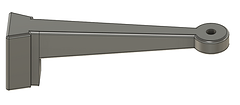AI vs Human Design
experiment


TL;DR AI is OK, conventional builds outperform it though
In this experiment, I compared the abilities of AI, humans, and proven designs. I started this experiment when I found out about Fusion 360 and its generative design abilities where it uses AI to calculate the best design based on plugged-in forces and materials. For the experiment, I used drone arms as the medium since they are relatively basic and don't have complex forces that need to be calculated and accounted for. Drone arms were also a good idea because the shape wasn't very complex so I could 3D print all of the parts. All the drone arms were built with a dovetail in the back so they can be slotted into a beam.
First I designed a basic drone arm in CAD that I could compare the AI one to. The arm was not made up of any complex shapes unlike the AI one. All it was was a dovetail with a tapered beam that connects to a platform for a force to be applied. The way that the AI worked was that it was worked off of the basic design by being told to not change the dovetail and the disk where force was being applied but instead change the arm in between. Over the course of about 30 minutes, the AI configured the arms to what it seemed fit. Once it was done it gave four candidates. I chose the strongest-looking one with the most similar mass (50±1g) so that the experiment was fair.
The proven design was a variant of an I-beam that was fit onto a drone arm and also built off of the original basic design keeping the dovetail and the disk. I-beams are commonly used in the construction of large structures such as bridges and skyscrapers. I tapered the I beam just like the two other arms so that it would fit appropriately. The I-beam is great for forces that are applied at the top but not so good at handling torque which luckily for the drone arm, is not experienced much.
The way that I applied the force to all of the arms is I put an eye hook through the hole in the disk and attached it to a scale that was attached to a pulley connected to a ratchet strap and a counterweight. I gradually ratcheted the strap until the arm broke. I repeated this a few times for each arm to get reliable arms.
The results of the experiment were that the AI arm would suddenly snap at about 85Kg, the standard arm would gradually bend until around 86kg where they were rendered useless (they would fully snap at around 100Kg), and the I-beam I didn't even have the facilities to break. I was able to get up to 107Kg and the I-beam didn't even bend or show signs of wear. In terms of drone use the the I-beam were probably the best due to their strength and the AI arm was slightly better than the standard arm because it didn't bend tho it was slightly weaker.


